A study of landscape painting development – Past, present and future perspectives
Main Article Content
Abstract
This study is focused on landscape paintings’ characteristics throughout history. It starts with primitive cave paintings passed through the ancient civilisations, then followed by the main art movements and styles and ends with the contemporary style landscape paintings. Future prospects and expectations for landscape representations were also considered. It was found that landscape representation has been the focus for most artists because of its link to their normal lives. In the primitive caves, illustrations of plants and animals were found covering caves’ walls. Landscape backgrounds were used in the ancient Egyptian civilisation and lost its significance in the Greece style to reappear with the Roman artists with special concern and perspective. The Renaissance era witnessed more progress in landscape paintings’ subjects and perspective. Baroque paintings initiated the focus on independent landscape paintings to be crystalised in the Romantic paintings and later on in the impressionists’ art works using distinctive painting techniques. The modernists approved landscape topic in their paintings to apply their unique techniques, whereas the contemporary landscape paintings have adopted abstract and free methods in employing various materials and colours. It is obvious that the landscape subject has been employed throughout all stages of art history because it is the key segment of their environment and life not only because of its aesthetic values. Realistic landscape representation in visual art and design is expected to progress in abundance in the near and far future as many people due to the pandemic circumstances have been deprived from naturally experiencing landscapes causing mental and health difficulties.
Keywords: Prehistoric period, ancient civilisations, Renaissance, Baroque, romantic.
Downloads
Article Details

This work is licensed under a Creative Commons Attribution 4.0 International License.
Authors who publish with this journal agree to the following terms:- Authors retain copyright and grant the journal right of first publication with the work simultaneously licensed under a Creative Commons Attribution License that allows others to share the work with an acknowledgement of the work's authorship and initial publication in this journal.
- Authors are able to enter into separate, additional contractual arrangements for the non-exclusive distribution of the journal's published version of the work (e.g., post it to an institutional repository or publish it in a book), with an acknowledgement of its initial publication in this journal.
- Authors are permitted and encouraged to post their work online (e.g., in institutional repositories or on their website) prior to and during the submission process, as it can lead to productive exchanges, as well as earlier and greater citation of published work (See The Effect of Open Access).
